A mass for asymptotically complex hyperbolic manifolds
A mass for asymptotically complex hyperbolic manifolds
A mass for asymptotically complex hyperbolic manifolds
Create successful ePaper yourself
Turn your PDF publications into a flip-book with our unique Google optimized e-Paper software.
hal-00429306, version 1 - 2 Nov 2009<br />
A MASS FOR ASYMPTOTICALLY COMPLEX HYPERBOLIC MANIFOLDS. 3<br />
where s is the radial coordinate in C m and gFS is the Fubini-Study metric of CP m−1 ,<br />
pulled-back to C m \{0}. Setting s = tanh r, we obtain CH m as the <strong>complex</strong> manifold<br />
C m endowed with<br />
gCH m = dr2 + (sinh2r) 2 η 2 + (sinh r) 2 gFS<br />
where η = − Jdr<br />
sinh2r is the standard contact <strong>for</strong>m on S2m−1 . This is an Einstein metric<br />
with scalar curvature −4m(m + 1) – the holomorphic sectional curvature is −4. The<br />
most useful description of CH m <strong>for</strong> us is yet another one. Let C m,1 denote the vector<br />
space C m+1 endowed with a Hermitian <strong>for</strong>m h of (<strong>complex</strong>) signature (m,1). Then the<br />
level set h = −1 in C m,1 , endowed with the induced metric, is a well-known Lorentz<br />
manifold, called Anti-de-Sitter space AdS 2m,1 . The quotient of AdS 2m,1 by the scalar<br />
action of S 1 is then a Riemannian manifold and it is precisely CH m .<br />
In this paper, we define <strong>asymptotically</strong> <strong>complex</strong> <strong>hyperbolic</strong> <strong>manifolds</strong> as complete<br />
Kähler <strong>manifolds</strong> (M 2m ,g,J) such that:<br />
(i) M minus a compact subset is biholomorphic to CH m minus a ball and,<br />
(ii) through this identification, g − gCH m = O(e−ar ) with a > m + 1<br />
2 (in C1,α ).<br />
Note the definition in [Her], while apparently weaker, is indeed equivalent (cf. the<br />
remark after Definition 3.1). The papers [Her, BH] prove rigidity results about <strong>asymptotically</strong><br />
<strong>complex</strong> <strong>hyperbolic</strong> <strong>manifolds</strong> that look like the rigidity part (the vanishing<br />
<strong>mass</strong> part) of a positive <strong>mass</strong> theorem. What is the <strong>mass</strong> in this setting ?<br />
In complete analogy with the real <strong>hyperbolic</strong> case, we will see the <strong>mass</strong> as a linear<br />
functional on some natural finite-dimensional vector space N attached to the model at<br />
infinity, CH m . This vector space N is best described as a set of parallel sections <strong>for</strong><br />
some natural connection ∇ CH on some natural vector bundle E over CH m . The vector<br />
bundle E is indeed Λ 2 J CHm ⊕ TCH m ⊕ R and the relevant connection comes from the<br />
flat connection on C m,1 . Details will be given in the text. To keep this introduction<br />
short, let us just point out that N identifies naturally to the vector space Λ 2 J Cm,1 of<br />
J-invariant 2-<strong>for</strong>ms on C m,1 and also admits a description as the set of functions u<br />
satisfying a natural third-order equation. Then we define the <strong>complex</strong> <strong>hyperbolic</strong> <strong>mass</strong><br />
by<br />
(3) µg(u) = − 1<br />
4 lim<br />
<br />
R−→∞<br />
SR<br />
<br />
∗ (div g + dTr g) u − 1<br />
<br />
Tr(g − gCHm)du ,<br />
2<br />
where everything on the right-hand side is computed with respect to the <strong>complex</strong><br />
<strong>hyperbolic</strong> metric gCHm at infinity. The following positive <strong>mass</strong> theorem holds in this<br />
context.<br />
Theorem 0.1 — Let (M,g,J) be a spin <strong>asymptotically</strong> <strong>complex</strong> <strong>hyperbolic</strong> manifold<br />
with Scalg ≥ Scalg CH m. When the <strong>complex</strong> dimension of M is even, we also assume that<br />
M is contractible. Then µg is a well defined linear functional, up to an automorphism<br />
of the model. It vanishes if and only if (M,g,J) is the <strong>complex</strong> <strong>hyperbolic</strong> space.<br />
The <strong>mass</strong> also satisfies a nonnegativity property : it takes non-negative values on<br />
some distinguished orbits of the action of PU(m,1). Under these assumptions, the <strong>mass</strong><br />
may very well take infinite values : we then decide that is infinite and the finiteness<br />
of the <strong>mass</strong> does not depend on the choice of the chart at infinity. A simple criterion<br />
<strong>for</strong> the <strong>mass</strong> to be finite is that the rate of fall-off to the model metric at infinity be<br />
sufficiently fast : a ≥ 2m + 1. A consequence of the positive <strong>mass</strong> theorem is that if<br />
a > 2m + 1, then (M,g,J) is <strong>complex</strong> <strong>hyperbolic</strong> ; it is the object of [Her, BH]. Our<br />
viewpoint yields a different proof, maybe more direct.




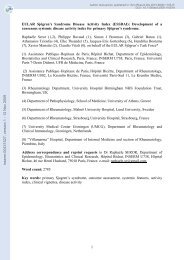
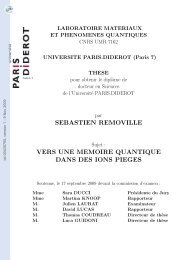
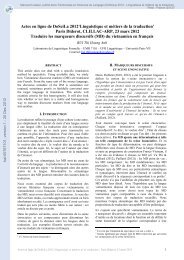
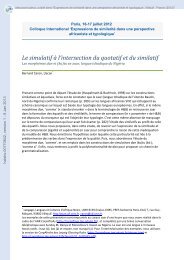
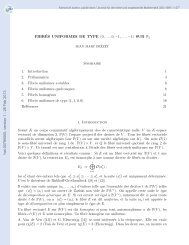
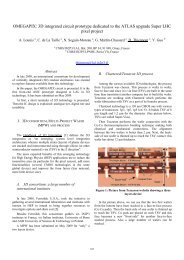
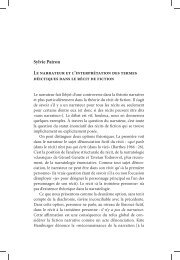
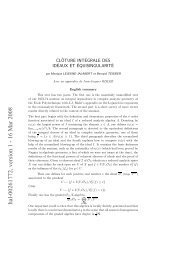
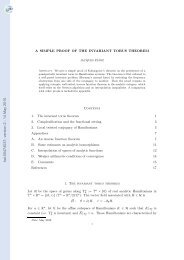

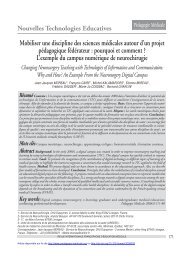

![[tel-00433556, v1] Relation entre Stress Oxydant et Homéostasie ...](https://img.yumpu.com/19233319/1/184x260/tel-00433556-v1-relation-entre-stress-oxydant-et-homeostasie-.jpg?quality=85)